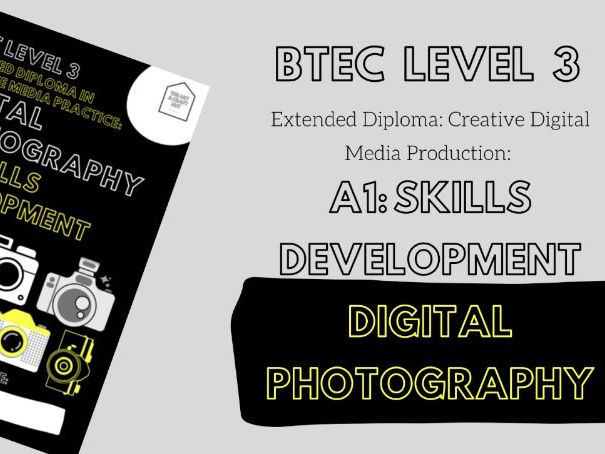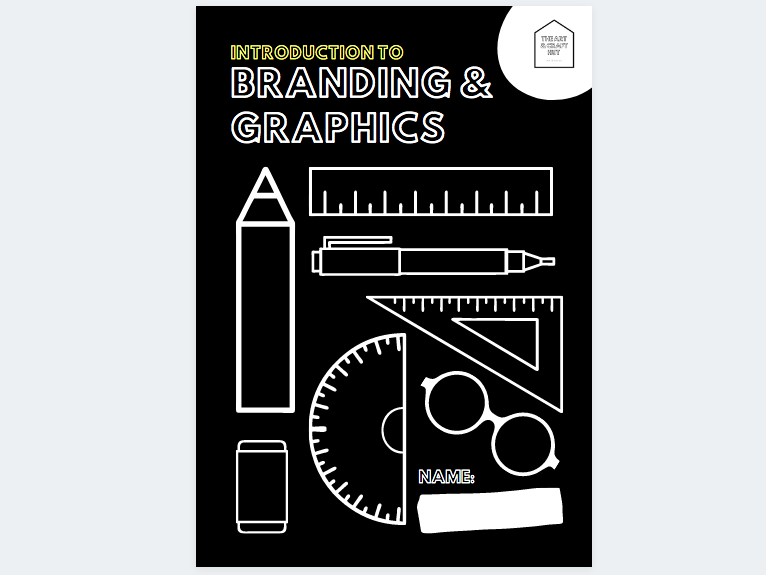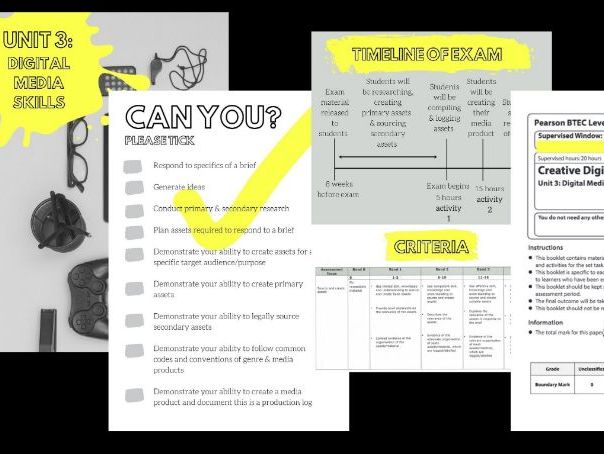139Uploads
62k+Views
100k+Downloads
Media studies

Film Making
A portfolio guide to short film making.
Including prompts such as:
Writing your script
Creating your storyboard
Task 1: Restructuring Time: Create a short 1 min film.
Shot Types
Shot Composition
Camera Angles
Camera Movement
Task 2: What was That?
Editing
Task 3: Final Film

BTEC Level 3-Extended Diploma in Creative Media Practice: Digital Photography-A1: Skills Development
90 page booklet - AC1: Informing ideas:
Skills for informing development of ideas and outcomes as they evolve
and progress.
A1.1 Explore and develop investigation skills for informing ideas
A1.2 Explore and develop problem solving skills
A1.3 Explore and develop creative technical skills
A1.4 Explore and develop professional skills and behaviours
A1.5 Explore and develop communication skills
Covered:
What is Digital Photography?
What are the benefits of Digital Photography?
Explore and develop investigation skills for informing ideas: Research
Target audience
Reading photographs
Camera Components
Exposure
Lighting
Framing
Black & white photography
Monochromatic photography
File storage: file formats
Experimental photography
What is a client ?
Developing ideas in relation to a brief
Responding to a brief

37 Page Workbook | Responding To A Media Commission (Moving Image) |
Responding To A Commission (Moving Image) | Rationale, Pitch, Proposal & Treatment (Script/Storyboard)
37 Page Workbook
Students will learn how to respond to a media commission. Appropriate for BTEC Creative Digital Media Production (Unit 8).
They will learn about the structure & process of a Rationale, Pitch, Proposal & Treatment (Script/Storyboard).

BTEC Level 3 Extended Diploma: Creative Digital Media Production: Unit 12 Website Production - LOC
BTEC Level 3 Extended Diploma: Creative Digital Media Production: Unit 12 Website Production LOC
18 page learning portfolio for remote or in class learning
FULLY PLANNED
In this unit you will:
Produce a website for a specific purpose and audience.
Bundle

BTEC Level 3 Extended Diploma:Creative Digital Media: Unit 12 Website Production - LOA, LOB & LOC.
BTEC Level 3 Extended Diploma:Creative Digital Media: Unit 12 Website Production - LOA, LOB & LOC.
95 pages - Fully planned - All learning & Assessment
LOA: Learning aim
In this unit you will:
Understand the codes and conventions of website production
What is website production?
What are the different purposes of a website?
What is a target audience?
Common components of a web page
Understanding the requirements of user experience & expectation
Brand Identity
Web accessibility
Interactive content
Assessment
LOB: Learning aim
In this unit you will:
Prepare materials for website production
What are website assets?
Primary & secondary assets
Legally sourcing secondary assets
Website assets - problem based task 1
Website assets - problem based task 2
Assessment
LOC: Learning aim
In this unit you will:
Produce a website for a specific purpose and audience.

Creating a Narrative & Storyboard For A Film Workbook/Presentation
Creating a Narrative & Storyboard For A Film
Production Timeline
Brainstorm ideas for your film’s narrative
Elements of a Story
Collect Content
Framing
Storyboard example
Storyboard Template
Image resources & references

The Grand Budapest Hotel - Film Analysis Guide - Exam Revision
The Grand Budapest Hotel - Film Analysis Guide - Exam Revision
Includes visual prompts for:
Ideology/Fascism
Costume
Props
Boy With Apple
Shots
Mendl’s box template - printable
Iconography
Setting

BTEC Level 3 Extended Diploma: Creative Digital Media Production: Unit 12 Website Production - LOA
BTEC Level 3 Extended Diploma: Creative Digital Media Production: Unit 12 Website Production LOA
50 page learning portfolio for remote or in class learning
FULLY PLANNED
In this unit you will:
Understand the codes and conventions of website production
What is website production?
What are the different purposes of a website?
What is a target audience?
Common components of a web page
Understanding the requirements of user experience & expectation
Brand Identity
Web accessibility
Interactive content
Assessment

2019 VCE VET Creative and Digital Media Examination Break Down - Exam Revision
Within this resource:
Tips for the exam
What do the questions mean?
What is the question asking me to do?
Glossary
3 exam sections
Section A breakdown
Section B breakdown

BTEC Level 3 Extended Diploma in Creative Media Practice -Magazine production - A2: Creative Project
BTEC Level 3 Extended Diploma in Creative Media Practice - Magazine production - A2: Creative Project
Assessment Criteria Covered:
A2.1 Inform ideas in response to a creative brief
A2.2 Apply problem solving skills in response to a creative brief
A2.3 Apply technical skills in response to a creative brief
A2.4 Demonstrate professional skills and behaviours in response to a creative brief
A2.5 Apply communication skills in response to a creative brief
Tasks/learning included:
Magazine Genre: Research task
Target audience
Common components of a magazine
Design task
Composition ( proximity, white space, contrast, alignment, hierarchy & repetition)
InDesign learning
What is typography?
Type design

Creating A Film Poster Series - 38 Page Booklet - Appropriate For Remote Or In School Learning
Within this resource learners will:
Identify film genre
Identify the target audience
Create a film narrative for a particular target audience & genre
Identify elements (codes & conventions) of film posters
Learn about film posters that were featured in a series
Create a film poster series to an industry standard
For the final project students will develop a series of 3 film posters for a fictional film that they write the story for.
Bundle

Introduction To Media: Graphics (Poster Design), Website Production, Photography & Branding
Introduction To Media for Secondary Learners: Graphics (Film Poster & Poster Design), Website Production, Digital Photography & Branding Bundle.
Full year of Media planned for Secondary learners

BTEC Level 3 Extended Diploma: Creative Digital Media Production: Unit 12 Website Production - LOB
BTEC Level 3 Extended Diploma: Creative Digital Media Production: Unit 12 Website Production LOB
25 page learning portfolio for remote or in class learning
FULLY PLANNED
In this unit you will:
Prepare materials for website production
What are website assets?
Primary & secondary assets
Legally sourcing secondary assets
Website assets - problem based task 1
Website assets - problem based task 2
Assessment

NEW BTEC Level 3 Extended Diploma in Creative Media Practice: Course Introduction Booklet
Introduction booklet for the NEW BTEC Level 3 Extended Diploma in Creative Media Practice.
Assessment criteria
Defining Assessment terms
Setting Smart Goals
YR 1 LEARNER ASSESSMENT SUBMISSION & DECLARATION
YR 2 LEARNER ASSESSMENT SUBMISSION & DECLARATION
PROFESSIONAL PRACTICE (Classroom management)

Film Analysis - Short Film Analysis Portfolio
This area of study provides an understanding of Film/Narrative terminology, construction of narratives and the identification and use of a range of codes and conventions of film.
Genre
Understanding of Narrative Structures
Exploration of Narrative conventions including Setting, Character, Point of View
Conflict and Resolution
Exploration of a range of Narrative Codes including Camera Techniques, Sound Design,
Editing, Lighting and Acting
Audience Engagement techniques

Pearson BTEC Level 3 Nationals- Creative Digital Media Production- Unit 3: Digital Media Skills Exam
This booklet contains learning material for the completion of the preparatory work and activities for the set task for Unit 3: Digital Media Skills exam.
ABOUT UNIT THREE EXAM:
The assessment period lasts eight weeks and comprises:
5 hours for Activity 1 under supervised conditions
15 hours for Activity 2 under supervised conditions.
**The best performing learners clearly used the preparatory period to:
research their chosen theme
develop a good understanding of relevant codes and conventions
explore how the client’s specific requirements have been used in existing media
products
gather a range of assets/material from secondary sources
**Specific marking guidance:
The marking grids have been designed to assess learner work holistically.
Rows within the grids identify the assessment focus/outcome being targeted.
When using a marking grid, the ‘best fit’ approach should be used.
● Examiners should first make a holistic judgement on which band most
closely matches the learner response and place it within that band.
Learners will be placed in the band that best describes their answer.
● The mark awarded within the band will be decided based on the quality
of the answer in response to the assessment focus/outcome and will be
modified according to how securely all bullet points are displayed at that
band.
● Marks will be awarded towards the top or bottom of that band depending
on how they have evidenced each of the descriptor bullet points.
**Formal supervision is the equivalent of examination conditions. Learners must work independently, cannot work with other learners, cannot talk about their work to other learners and will only be able to access the materials specified in the assessment.
**Independent preparation is required in this assessment so that learners are able to source assets for their product. Centres need to make provision for this preparation using scheduled lessons and ensuring that learners have access to information and equipment that may be required. Learners should be working independently rather than being taught
or directed.
**Monitored preparation is provided when learners produce materials that are used in any formally supervised session. This includes notes, artefacts, assets, plans etc. as specified in the sample assessment. Monitored sessions are where learners are being directly observed.
They may have, where specified, access to their own outcomes from preparation, access to the internet and use of appropriate resources.
Learners are working independently and teachers/tutors will be able to authenticate that the outcomes for formal assessment meet
the requirements and are authentic. At the end of the monitored preparation, centres will retain the assets which will be provided to learners during the formal supervised assessment.

Animation - Thaumatrope - Printable/Digital Portfolio
Animation - Thaumatrope - Printable/Digital Portfolio
Animation timeline
12 Principles of Animation
The media process
The Thaumatrope: Development, Pre-production, Production & Distribute

The Anatomy Of Film - Hand out - Class Display - Printable & Digital
The Anatomy Of Film - Hand out - Class Display - Printable & Digital
Narrative
Cinematography
Mise-en-scene
Editing

FREE ART/MEDIA WORKSHEETS | POP ART | COLOUR VALUES | PERSPECTIVE DRAWING | WOMAN WITH A SUNFLOWER
FREE ART/MEDIA WORKSHEETS | POP ART | COLOUR VALUES | PERSPECTIVE DRAWING | WOMAN WITH A SUNFLOWER ANALYSIS | & MORE
Pop Art Coloring: Use different pop art styles to color the images below.
Make your selfie pop: By “pop,” we mean Pop Art, from the term “popular.” It is a visual arts movement that drew influence from people and things in popular culture, such as food, film, and everyday
objects. One of the leaders of this movement is Andy Warhol, a successful American artist who used bright colors and silkscreen to mass-produce his art. Now let’s create your own pop art portrait inspired by Andy Warhol.
Colour Code - Tonal Values: Hues or pure colors acquire tonal values with the addition of gray, black, or white. Make your own tonal value chart using the three primary hues, to discover new shades, tints and tones! You can use this later as a reference for painting.
An Exercise on Perspective: Perspective is an important part of visual art. It gives flat drawings a sense of depth and immerses viewers in your work. Copy the illustration from the first row to the second row. Observe the horizon line and vanishing points. Then, pick an object near you. Draw it in two perspectives using the boxes on the last row.
Beyond the Canvas: This is a photo of an oil painting by Mary Cassatt called Woman with a Sunflower, created in 1905. Look closely
at the artwork and take note of your first impressions.
A mix of mediums: In the boxes below, use the materials indicated to create your own artwork. Each artwork should answer the question; If I could create my own planet, what would it look like?
History of Video Games: This short quiz aims to demonstrate your knowledge on the origins of video games. Write your answers on the blank space below each question.
Creating letterforms: You can create calligraphic pieces with the simplest of tools. It’s easy to get distracted by the many brands and products, but you can do it with what you have.
How do you see yourself?: Using a mirror, look closely at all the shapes, colors, and other features on your face, then with the mirror as your guide, draw and color your portrait on a piece of paper. Ask your classmates for feedback about your portrait.




















